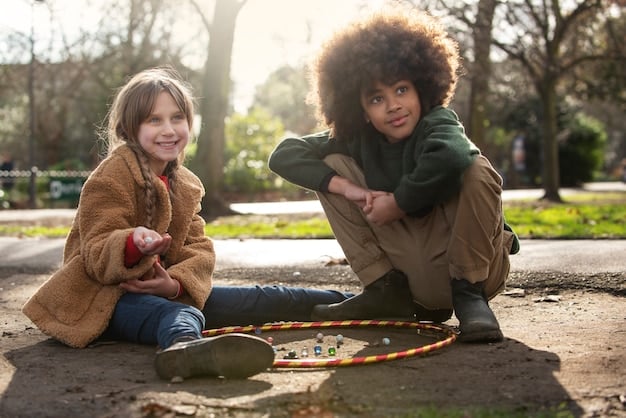Building Emotional Resilience: 7 Skills for Children’s Future

Building Emotional Resilience in Children: 7 Essential Skills for a Healthy Future encompasses teaching children how to manage stress, understand emotions, and bounce back from adversity, crucial for their overall well-being and future success.
Building Emotional Resilience in Children: 7 Essential Skills for a Healthy Future is not just a concept; it’s a necessity in today’s fast-paced world. Equipping our kids with these tools early on helps them navigate life’s challenges with confidence and grace. Let’s explore how we can foster this vital resilience.
Understanding Emotional Resilience in Children
Emotional resilience is the ability to adapt well in the face of adversity, trauma, tragedy, threats, or even significant sources of stress. It’s about bouncing back from difficult experiences. For children, developing this skill is essential for navigating the ups and downs of growing up.
But what does emotional resilience really look like in kids? It’s not about never experiencing negative emotions or always being happy. Instead, it’s about having the tools to cope with those emotions in a healthy way.
Why is Emotional Resilience Important?
Emotional resilience acts as a buffer against mental health issues, academic struggles, and relationship problems. It helps children develop into well-adjusted adults who can handle life’s inevitable challenges.
- Improved mental health: Resilient children are less likely to experience anxiety, depression, and other mental health problems.
- Better academic performance: They can cope with stress and setbacks in school, leading to improved grades and a stronger sense of accomplishment.
- Healthier relationships: They are better equipped to handle conflict and build strong, supportive relationships with others.

In essence, emotional resilience lays the foundation for a happier, healthier, and more successful life.
Skill 1: Identifying and Expressing Emotions
A key element of emotional resilience is the ability to recognize and express feelings effectively. Children who can understand their emotional landscape are better equipped to manage their reactions and seek support when needed.
This skill starts with helping children learn the names of different emotions and how they feel in their bodies. Parents and educators can use various tools and techniques to encourage emotional literacy.
How to Encourage Emotional Literacy
Creating a safe space for children to express their emotions without judgment is crucial. This can be achieved through open conversations, storytelling, and creative activities.
- Use emotion charts: Visual aids that display different emotions and their corresponding facial expressions can help children identify what they’re feeling.
- Read books that explore emotions: Stories can provide relatable examples of characters experiencing different feelings and how they cope.
- Encourage journaling: Writing about emotions can help children process their experiences and develop self-awareness.
By fostering emotional literacy, we empower children to understand and manage their feelings more effectively.
Skill 2: Developing Problem-Solving Skills
Problem-solving involves finding solutions to difficult or complex issues. Teaching children problem-solving skills enhances their self-efficacy and empowers them to face challenges head-on.
Breaking down problems into manageable steps and encouraging children to brainstorm potential solutions is crucial. This approach helps them develop a sense of control and competence.
Strategies for Enhancing Problem-Solving
Helping children develop effective problem-solving skills requires a combination of guidance, support, and opportunities for practice. Model positive problem-solving behavior and encourage them to think critically.
- Encourage brainstorming: Help children generate multiple solutions to a problem before choosing the best one.
- Teach the “think-aloud” method: Verbalize your own problem-solving process to model effective strategies.
- Provide opportunities for practice: Allow children to solve age-appropriate problems independently, offering support when needed.
Skill 3: Cultivating a Positive Self-View
A positive self-view plays a crucial role in emotional resilience, acting as a buffer during difficult times. Children who like themselves are more likely to persevere and bounce back from setbacks.
Positive self-talk and celebrating achievements can help children develop a healthy sense of self-worth. Reinforcing their strengths and acknowledging their efforts fosters a resilient mindset.
Techniques for Building Self-Esteem
Boosting self-esteem involves consistent encouragement, constructive feedback, and opportunities for success. Celebrate small victories and help children recognize their unique talents.

Here are some specific techniques to foster a positive self-view:
Affirmations: Encourage children to repeat positive statements about themselves, such as “I am capable” or “I am loved.”
Focus on strengths: Help children identify their strengths and talents and find opportunities to use them.
Celebrate achievements: Acknowledge and celebrate their accomplishments, no matter how small.
By reinforcing their strengths and celebrating their successes, we help children develop a positive self-view that supports their emotional resilience.
Skill 4: Building Strong Relationships
Strong relationships provide children with a sense of belonging and support, which is essential for emotional resilience. Positive connections to family, friends, and community members offer a safety net during challenging times.
Encouraging children to develop empathy and communication skills enhances their ability to build and maintain strong relationships. These skills help them navigate social interactions and resolve conflicts effectively.
Strategies for Fostering Healthy Relationships
Helping children build strong relationships involves teaching them essential social skills, such as active listening, empathy, and conflict resolution. Model healthy relationship behaviors and encourage them to practice these skills in their own interactions.
Here are some strategies to develop healthy relationships:
Teach empathy: Help children understand and share the feelings of others by discussing different perspectives and emotions.
Encourage active listening: Teach children to pay attention to what others are saying without interrupting or judging.
Model healthy communication: Demonstrate respectful and assertive communication in your own relationships.
By fostering strong relationships, we provide children with a support system that bolsters their emotional resilience.
Skill 5: Learning to Manage Stress
Stress management is a crucial skill for emotional resilience, enabling children to cope with pressure without becoming overwhelmed. Teaching relaxation techniques and coping strategies reduces the impact of stress on their well-being.
Simple practices like deep breathing, mindfulness, and physical activity can help children regulate their stress levels. These techniques empower them to take control of their emotional state.
Techniques for Teaching Stress Management
Introducing stress-management techniques early in life equips children with tools to navigate challenges independently. Practice these techniques together and encourage them to use them whenever they feel overwhelmed.
Consider the following techniques when teaching stress-management:
- Deep breathing exercises: Teach children to slow down their breathing and focus on each inhale and exhale.
- Mindfulness meditation: Encourage children to pay attention to the present moment without judgment.
- Physical activity: Regular exercise can help reduce stress and improve overall well-being.
By teaching effective stress-management techniques we empower children to cope with pressure in a healthy way.
Skill 6: Developing Realistic Optimism
Realistic optimism involves maintaining a positive outlook while acknowledging challenges. Children with this trait are more likely to persevere, viewing setbacks as temporary and manageable.
Teaching children to focus on the positive aspects of situations and reframe negative thoughts fosters a resilient mindset. This approach helps them approach life with hope and determination.
How to Encourage Realistic Optimism
Cultivating optimism involves teaching children to challenge negative thoughts and focus on the positive. Help them reframe setbacks as opportunities for growth and encourage them to look for the good in every situation.
Here are steps related to developing:
Challenge negative thoughts: Help children identify and challenge negative thoughts by asking questions like, “Is that really true?”
Reframe setbacks: Encourage children to view failures as learning opportunities and to focus on what they can do differently next time.
Focus on the positive: Help children identify and appreciate the positive aspects of their lives.
Skill 7: Fostering Adaptability
Adaptability is the ability to adjust to new conditions and challenges. Flexible children are more likely to cope with change without becoming overwhelmed as they navigate life’s unpredictable moments.
Encouraging children to embrace new experiences and approaches cultivates a resilient mindset. Acknowledging their strength and support builds internal reliance even in uncertain times.
Fostering Adaptability
Adaptive children are able to cope with the world around them in a positive way.
Here’s how to increase the adaptability of your child:
- Flexibility
- Problem-Solving Skills
- Stress-Management
| Key Element | Brief Description |
|---|---|
| 😊 Emotional Literacy | Understanding and expressing emotions effectively. |
| 💪 Problem-Solving | Finding solutions to difficult or complex issues. |
| 🌟 Positive Self-View | Cultivating a healthy sense of self-worth. |
| 🫂 Supportive Relationships | Building strong connections with family and friends. |
FAQ About Building Emotional Resilience
▼
Emotional resilience helps children navigate life’s challenges, manage stress, and develop healthy coping mechanisms. It contributes to overall well-being and future success.
▼
Use emotion charts, read books about feelings, and encourage journaling to help your child understand and express their emotions. Create a safe space for them to share their feelings without judgment.
▼
Encourage brainstorming, teach the “think-aloud” method, and provide opportunities for practice. Break down problems into manageable steps and support your child as they find solutions.
▼
Use affirmations, focus on strengths, and celebrate achievements. Provide consistent encouragement and constructive feedback to help your child develop a healthy sense of self-worth.
▼
Teach deep breathing exercises, mindfulness meditation, and encourage regular physical activity. These techniques can help children regulate their stress levels and improve their overall well-being.
Conclusion
By fostering these seven essential skills—identifying emotions, problem-solving, positive self-view, strong relationships, stress management, realistic optimism, and adaptability—we empower children to develop emotional resilience. These skills support their well-being and successful futures.





